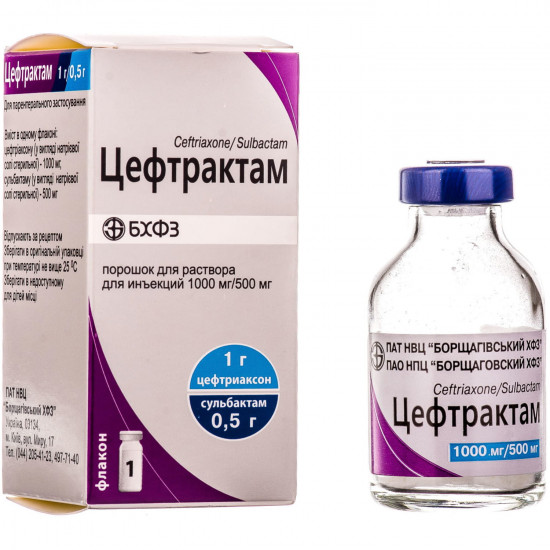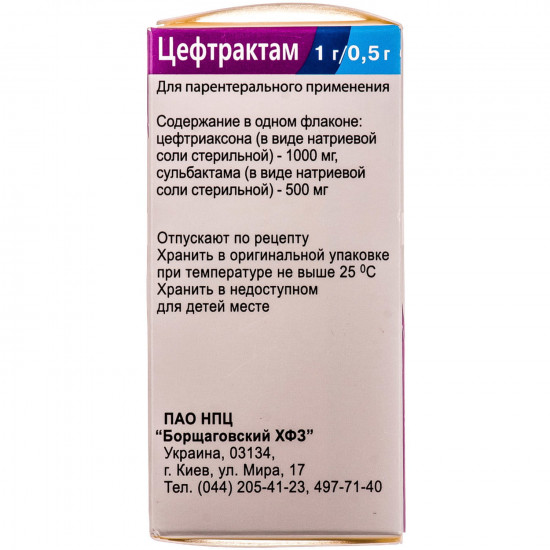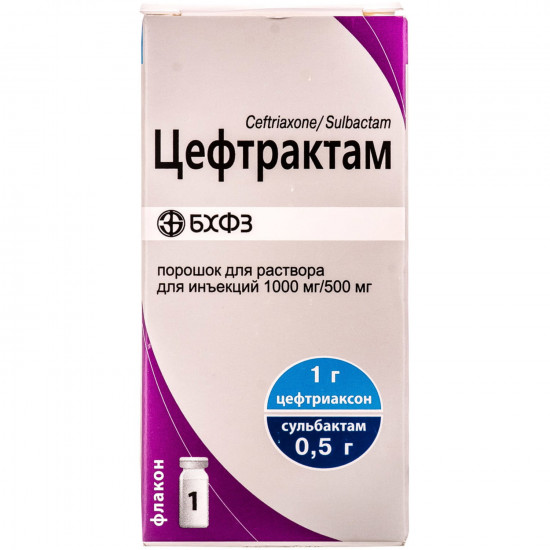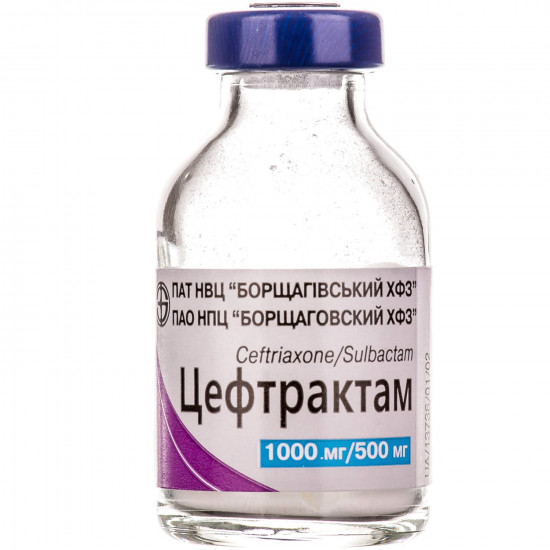







- Stock: In Stock
- Model: 179360
0% Customers recommend this product
-
5 Awesome0%
-
4 Great0%
-
3 Average0%
-
2 Bad0%
-
1 Poor0%
Reviews Over Tseftraktam time. for solution for infection. 1000mg/500mg fl. No. 1
- (0)
Total Reviews (0)
click here write review to add review for this product.
Report this review.
Description
Powder for solution for injections Tseftraktam is shown at infectious and inflammatory diseases, caused by microorganisms, sensitive to drug:
- an infection of lower parts of airways;
- sharp bacterial otitis of a middle ear;
- an infection of leather and soft tissues;
- an infection of kidneys and urinary tract;
- an infection of bones and joints;
- septicaemia;
- an infection of abdominal organs (including peritonitis, infections of biliary tract and digestive tract);
- bacterial meningitis;
- gonorrhea;
- prevention of infections at surgical interventions.
At Tseftraktam's appointment needs to observe the official recommendations about antibiotic treatment and the recommendation about prevention of an antibiotikorezistentnost.
Structure
Active ingredients: tseftriakson, to sulbakta;
1 bottle supports a tseftriakson (in the form of sodium salt sterile) 500 mg or 1000 mg and a sulbaktama (in the form of sodium salt sterile) 250 mg or 500 mg respectively.
Contraindication
- Hypersensitivity to a tseftriakson, a sulbaktam, to any antibiotic of a tsefalosporinovy row, to lidocaine (intramuscular introduction).
- Existence in the anamnesis of heavy reactions of hypersensitivity (for example, anaphylactic reactions) to any other type beta laktamnykh antibacterial agents (penicillin, monobaktama, karbapenema).
- Disease of a digestive tract in the anamnesis, especially nonspecific ulcer colitis, enteritis or colitis connected with use of antibacterial medicines.
- Premature newborns up to 41 weeks taking into account the term of pre-natal development (gestational age + calendar age) *.
- Full-term newborns (up to 28 days of life):
- with a hyperbilirubinemia, jaundice, a hypoalbuminemia, acidosis (at these states the linking of bilirubin with blood proteins decreases) *;
- at requirement (or it is expected that there will be a requirement) intravenous administration of medicines of calcium or kaltsiysoderzhashchy solutions because of risk of formation of precipitated calcium superphosphates of tseftriaksona-calcium in lungs and kidneys.
* In the researches in vitro it was shown that tseftriakson can force out bilirubin from communication with blood serum albumine that results in possible risk of developing bilirubinovy encephalopathy at such patients.
Before intramuscular introduction of a tseftriaksona/sulbaktam should exclude surely existence of contraindications to use of lidocaine if it is applied as solvent (see the section "Features of Application", the instruction for medical use of lidocaine, especially contraindications).
Solutions of a tseftriaksona/sulbaktam containing lidocaine never should be entered intravenously.
Route of administrationto Apply
intravenously or intramusculary. Before therapy it is necessary to exclude presence at the patient of hypersensitivity to an antibiotic and to lidocaine (in case of an intramuscular method of administration), having taken skin samples.
Daily dose for adults and children from 12 years makes 1.5-3 g of the medicine Tseftraktam (1-2 g in terms of tseftriakson) 1 time a day (each 24 hours). In hard cases or at infections which causative agents have reduced sensitivity to a tseftriakson it is possible to increase a daily dose of Tseftraktam to 6 g (4 g of a tseftriakson).
Feature of application
Pregnant
during pregnancy, especially in the I trimester, it is possible to use drug, only if the expected advantage for the woman exceeds potential risk for a fruit.
Children
use Drug in pediatric practice.
Drivers
to Patients should becareful at control of motor transport or other mechanisms.
Overdose
Symptoms. There is limited information on overdose cases. In case of overdose strengthening of manifestations of side reactions is possible.
Treatment. It is necessary to carry out symptomatic therapy. The hemodialysis and peritoneal dialysis are not effective. There is no specific antidote.
Side effects
- Infection and invasion: development of superinfection (consecutive fungal infections, including a candidiasis, mycosis of genitals and the infections caused by resistant microorganisms) is possible.
- Digestive tract: liquid excrements / diarrhea, nausea, vomiting, meteorism, stomatitis, glossitis, dysgeusia, gastrointestinal bleeding; pancreatitis (possibly, because of obstruction of bilious ways precipitated calcium superphosphates of calcic salt of a tseftriakson), a pseudomembranous coloenteritis.
- Gepatobiliarnaya system: a pseudo-cholelithiasis bilious puzirya, precipitation of calcic salts of a tseftriakson in a gall bladder with the corresponding symptomatology at children, a reverse cholelithiasis at children; increase in activity of hepatic Transaminases, alkaline phosphatase in blood plasma, a hyperbilirubinemia, a kernicterus.
- System of blood formation: an eosinophilia, a leukopenia, a leukocytosis, a neutropenia, a lymphopenia, thrombocytopenia, a thrombocytosis, a granulocytopenia, a basophilia, anemia, including hemolytic anemia, lengthening/shortening of a prothrombin time, a coagulopathy, epistaxis, a prothrombinopenia, the Agranulocytosis. During long-term treatment it is necessary to control a blood pattern regularly.
- Immune system: reactions of hypersensitivity, including anaphylactic reactions (including acute anaphylaxis), anaphylactoid reactions, serum disease, Yarisha-Gerksgeymer's reaction.
- Nervous system: headache, dizziness, tremor, spasms.
- Organs of hearing and balances: vertigo.
- Urinary system: increase in level of urea and creatinine in blood, a cylindruria, a glucosuria, a hamaturia, an oliguria, interstitial nephrite.
- Skin and hypodermic cellulose: skin rashes, allergic dermatitis, an itch, a small tortoiseshell, hypostases, including a Quincke's disease, a dieback, a multiformny exudative erythema, Stephens-Johnson's syndrome, a toxic epidermal necrolysis (Lyell's disease), DRESS syndrome (medicamentous rashes with an eosinophilia and system manifestations), sharp generalized exanthematous pustulez.
- Cardiovascular frustration: increase/lowering of arterial pressure, heart consciousness.
- Respiratory frustration: short wind, bronchospasm.
Interaction
Non-steroidal anti-inflammatory drugs, antiagregant, antagonists of vitamin K (such as warfarin). Increase in risk of bleedings. Strengthening of effect of antagonists of vitamin K. Frequent control of the international normalized ratio (INR) and the corresponding correction of doses of antagonists of vitamin K in time and after application of a tseftriakson is recommended.
Aminoglycosides. There are contradictory data on potential strengthening of toxic impact of aminoglycosides on kidneys at their application with cephalosporins. In such cases in clinical practice it is necessary to monitorirovat carefully the level of aminoglycosides and function of kidneys.
In need of the combined treatment should enter them separately into different places and not to mix in one syringe or in one solution for infusion because of physical and chemical incompatibility.
Bacteriostatic antibiotics (chloramphenicol, tetracyclines). Decrease in bactericidal effect of a tseftriakson is possible.
Storage conditions
In original packing at a temperature not above 25 °C.
to Storeout of children's reach.
Expiration date - 2 years.
Specifications
| Characteristics | |
| Active ingredients | Sulbaktam, Tseftriakson |
| Amount of active ingredient | 1 g + 0.5 g |
| Applicant | BHFZ |
| Code of automatic telephone exchange | J01DD54 Tseftriakson, combinations |
| Interaction with food | It doesn't matter |
| Light sensitivity | Not sensitive |
| Market status | Traditional |
| Origin | Chemical |
| Prescription status | According to the prescription |
| Primary packing | bottle |
| Producer | PUBLIC JOINT STOCK COMPANY OF NVTS BORSHCHAGOVSKY HFZ |
| Quantity in packing | 1 pieces. |
| Release form | powder for injections |
| Route of administration | Intravenous |
| Sign | Domestic |
| Storage temperature | from 15 °C to 25 °C |
| Trade name | Tseftraktam |



















































